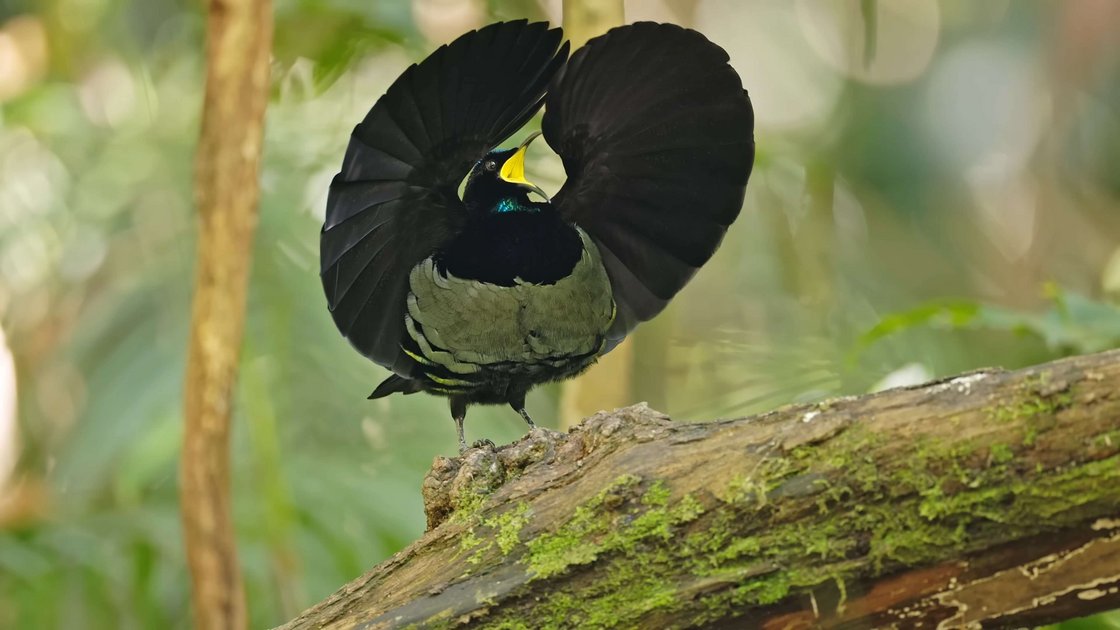- Home /
- University /
- Infoservice /
- Press Releases /
- Birds of paradise: sex and the wonderful mechanics of circular wings display
Research
Birds of paradise: sex and the wonderful mechanics of circular wings display
The circular wings display of Victoria’s riflebird – a bird of paradise species found in Australia – is a fascinating sight, since it at first glance looks more like the flower of an exotic plant than what we know as a bird. As the researchers of a study led by the University of Veterinary Medicine Vienna have now been able to prove for the first time, there is a very special physical ability behind this unusual courtship behavior. This ability distinguishes the riflebirds from all other birds and is involved in both visual and acoustic features of display. An attractive and complex combination that potential partners will find hard to resist.

Humans aren’t the only species in which males show off for females. From a scientific perspective, sexual selection through female choice has driven the evolution of some of the most sophisticated signaling behaviors in animals. These displays often require specialized morphological adaptations and can involve signals in multiple sensory modalities. In addition, visual and acoustic signals are often precisely choreographed in temporally structured courtship displays.
Shapeshifters: Unique acrobatics enable extraordinary visual effects
The riflebirds (genus Ptiloris) are quite a remarkable group of birds. The researchers of the study, which has just been published in the “Biological Journal of the Linnean Society”, have now been able to demonstrate for the first time that these birds of paradise achieve their remarkable courtship postures by hyperextending the wrist joint – something quite normal for humans, but previously unknown in birds, which lock the wrist in place to allow more stability during flight. “This goes far beyond the maximum extension of the wrist of all other known birds,” says the first author of the study, Thomas MacGillavry from the Konrad Lorenz Institute of Ethology (KLIVV) at Vetmeduni, emphasizing the uniqueness of this ability.
Sound and vision: an impressive multimedia spectacle with an ingenious trick
But the fascinating findings go even further, as the senior author of the study Leonida Fusani, head of KLIVV, explains: “Using video collected in the field, we then show that this hypermobility is required for a sonation [the production of sound not involving the vocal organs] unique to riflebirds, and find that the yellow interior of the mouth is displayed in the dynamic phase of display.” As a result, the sonation cannot be produced when the yellow inside of the mouth is flashed open, creating a unique kind of tradeoff.
Behind the beautiful façade: just the one thing in the head
Finally, the researchers used a large morphometric dataset to describe patterns of sexual dimorphism in wing length in different bird of paradise species to look for evidence of sexual selection for large and structurally modified wings used in courtship displays, particularly in the riflebirds.
With the sum of their findings, the researchers took a major step forward in what we know about riflebird displays - despite the fact that the general patterns of displaying behavior of these birds are well described in the literature. “Our study has nonetheless revealed that these performances are much more mechanically intricate than previously anticipated, and highlights how mate choice can drive the evolution of extreme behavioural and morphological phenotypes that function exclusively for sexual display.” said Thomas MacGillavry and Leonida Fusani.